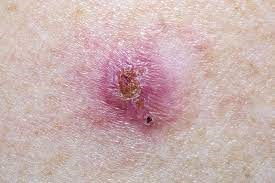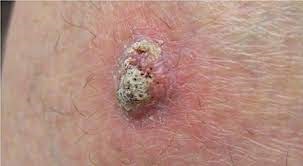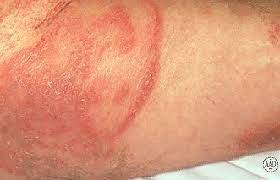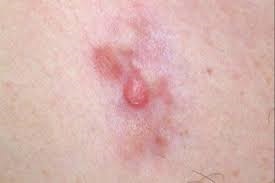There are times when you check your skin and see a mole, brownish spots and speckles, or lesions. You might think you have a skin infection, skin reaction, or worse, skin cancer. If these manifestations are symptoms of skin cancer, then you need to know more about the types, symptoms, and treatments of this condition.
Dr. Lepine, Sanaya Gandhi, Mallory Hoskins, and Brittany Starnes, your #1 Rock Hill dermatology team, explain everything you need to know about skin cancer, the types, and treatments.
What Is Skin Cancer?
Skin cancer is the irregular, uncontrolled, or abnormal growth of skin cells. It often appears in the form of nodules, spots, speckles, lesions, or irregular patches on the skin.
Skin cancer is very common in the United States, and 1 in 5 Americans develops skin cancer by age 70. Various factors contribute to the development of skin cancer, which is why you need to understand everything you can about skin cancer.
Skin Cancer Symptoms You Should Know
One of the ways you can prevent or treat skin cancer is to be aware of its symptoms. Knowing the symptoms of skin cancer will make you aware of when you start developing the cancerous cells.
Here are symptoms of skin cancer you should watch out for:
- Flat white, yellow, or waxy scar-like areas on the skin
- Shiny nodules or bumps
- Open sores that do not heal
- Reddish patches or irritated areas
- Wart-like growths that crust and bleed occasionally
- Scaly red patches with irregular borders
- New growth or change in the growth of an existing mole
- Pearly or waxy bump on the face, neck, and ears
- Flat, colored, scaly lesions on arms, legs, or trunk
Types of Skin Cancer
There are several types of skin cancer that you should know.
Basal Cell Carcinoma

Basal cell carcinoma (BCC) is the most common type of skin cancer. It is caused by the intense exposure of the skin to ultraviolet radiation. BCCs involve the abnormal and irregular growth of the skin’s basal cells in the epidermis (the outermost layer of the skin).
Basal cell carcinoma usually develops on areas of the skin that are exposed to the sun, such as the neck, face, shoulders, scalp, ears, and back. They are characterized by a pearl-like bump, pinkish patch of skin, or flesh-colored round skin growth. This cancer is usually associated with people with fair skin and people with years of exposure to the sun or indoor tanning.
Detecting and treating this cancer early is very essential as it can grow deep into the nerves and bones, causing additional damage.
Squamous Cell Carcinoma

The squamous cell carcinoma is characterized by scaly patches, sores that heal and reopen, or red, firm bumps on the skin. They mostly affect skin areas that are exposed to the sun or areas that reveal signs of sun damage, wrinkles, and age spots. These areas include the scalp, hands, neck, face, and ears. Early diagnosis and treatment are also essential for this skin cancer type to prevent further damage or health complications.
Squamous cell carcinoma is the second most common type of skin cancer. This type of skin cancer is associated with the abnormal and irregular growth of the skin’s squamous cells in the epidermis. It is usually caused by excess exposure to UV rays from the sun and tanning beds.
Melanoma

Melanoma is often referred to as the most serious type of skin cancer due to its ability to spread. This skin cancer develops from skin cells called melanocytes. Melanocytes are skin cells that produce the melanin pigment, the pigment responsible for giving the skin its color. They can also be caused by exposure to UV rays from the sun and tanning beds.
Melanomas usually resemble a mole or may arise from within an existing mole. They can appear on any part of the body, even in areas not typically exposed to sunlight. Melanoma is very dangerous, so you have to detect and treat it early.
Additional Forms of Skin Cancer
Merkel Cell Carcinoma

Merkel cell carcinoma is a rare type of skin cancer that is considered aggressive due to its ability to spread from one part of the body to another and also return after treatment.
It is characterized as a fast-growing nodule, dome-shaped growth, or red spot. This type of skin cancer requires prompt medical attention.
Sebaceous Carcinoma

Sebaceous carcinoma is also a rare type of skin cancer. It is known to be an aggressive skin cancer due to its tendency to spread. Like other skin cancer types, it is caused by excess exposure to sunlight. It can also be caused by a weakened immune system due to medical conditions.
Sebaceous carcinoma usually affects the eyelids and may also cause bumps on the skin. It usually is a painless thickening of skin or lump on the eyelid.
Cutaneous T-Cell Lymphoma

Cutaneous T-cell lymphoma is a rare type of skin cancer and is also categorized as blood cancer due to its nature. It first begins in a white blood cell called the T-lymphocyte (T-cell). These white blood cells are found in the skin.
Once these white blood cells begin to grow abnormally, a rash appears and then worsens, looking like a case of eczema. The skin might also begin to feel hot, sore, and itchy.
Dermafibrosarcoma Protuberans

This is a rare cancer that begins in the dermis, the middle layer of the skin. It then grows slowly but does not often spread to other parts of the body.
This form of skin cancer often starts with small bumps on the skin or looks like a scar. If you do not treat this skin cancer, it can grow deep into the fat, muscle, and bone.
Self-Check for the Warning Signs of Skin Cancer
For early diagnosis, you should learn the ABCDE warning signs of skin cancer. These self-check tips will help you detect skin cancer earlier.
- Asymmetry- Melanomas are asymmetrical. If you draw a line through the middle of the lesion, you won’t get two even halves.
- Border- Common moles tend to have even and smooth borders, but melanomas have uneven, notched, or scalloped edges.
- Color- Watch for moles or lesions with multiple colors, shades of brown, black, tan, or changing colors.
- Dark or Diameter- Watch out if the lesion is about 6mm or a quarter inch in diameter. They can also be darker as they grow.
- Evolving- Melanomas evolve, changing in size, shape, color, or even symptoms.
Skin Cancer Treatment From Rock Hill Dermatology Center

Rock Hill Dermatology Center offers effective skin cancer treatments in Rock Hill, SC. If you notice any skin problems or signs of skin cancer, you should contact our dermatology team for assistance. Book an appointment with us now!




